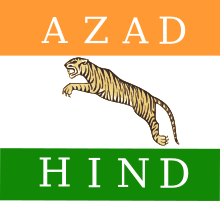Jaganath Rao Bhonsle
Major General Jaganath Rao Bhonsle also known as Jagannathrao Krishnarao Bhonsle[1] (10 December 1906[1] – 1963) was an officer of the British Indian Army subsequently the Indian National Army, a minister for armed forces in the Azad Hind Government, and later a minister in the post-independence Nehru Government in India.[2][3][4]
Bhonsle graduated from Prince of Wales Royal Indian Military College, Dehradun in 1926 and then went to the Royal Military College, Sandhurst where on 2 February 1928 he was commissioned as a second lieutenant.[5] He would have then spent a year attached to a British Army regiment in India before posting to his permanent British Indian Army unit on 12 April 1929,[1] which was the 5th Royal battalion, 5th Mahratta Light Infantry of the British Indian Army.[6] He was promoted lieutenant 2 May 1930 and captain 2 February 1937.[1]
He was stationed at Singapore in 1941 and was taken PoW after the Fall of Singapore. Bhonsle was one of the most senior officer to join the Indian National Army and was appointed the head of the Hindustan Field Force of the First INA. He was appointed the commander of the INA at the time Azad Hind was proclaimed[7][8] but later reverted his allegiances to turn spy for the Allies.[9] Assigned the code B1189, Bhonsle's intelligence was especially important in tracing the last movements of Subhas Bose in August 1945, following the collapse of Azad Hind.
He was cashiered from the British Indian Army as a captain on 13 September 1946.[10]
Following Indian independence in 1947, Bhonsle was appointed deputy minister for rehabillitation in the Nehru government, and was key in implementing the National Discipline Scheme.[11][12]
Notes
- 1 2 3 4 October 1939 Indian Army List
- ↑ Nehru 1982, p. 86
- ↑ Sareen 1988, p. 378
- ↑ Pan-Asia Newspaper Alliance, Hong Kong 1957, p. 143
- ↑ London Gazette 3 February 1928
- ↑ Khan 1946, p. 279
- ↑ Bose 2004, p. 276
- ↑ Mercado 2002, p. 78
- ↑ Bose 2004, p. 23,276
- ↑ London Gazette 20 September 1946
- ↑ Ajgaonkar 1964
- ↑ Butalia 2000, p. 220
References
- Ajgaonkar, G.P. (1964), Senapati Bhonsale: The I.N.A Chief & Father of National Discipline Scheme., N.R. Ralkar, ASIN B0007JP1JY .
- Butalia, Urvashi (2000), The Other Side of Silence: Voices from the Partition of India., C. Hurst & Co Publishers, ISBN 1-85065-533-2 .
- Bose, Mihir. (2004), Raj, Secrets, Revolution: A Life of Subhas Chandra Bose ., Grice Chapman Publishing., ISBN 0-9545726-4-5 .
- Khan, Shah Nawaz. (1946), My Memories of I.N.A. & Its Netaji., Rajkamal Publications., ASIN B0000CQY8U .
- Mercado, Stephen C (2002), The Shadow Warriors of Nakano: A History of the Imperial Japanese Army's elite intelligence school., Brassey's., ISBN 1-57488-538-3 .
- Nehru, Jawaharlal; et al. (1982), Selected Works of Jawaharlal Nehru., Orient Longman. .
- Sareen, T.R (1988), Select Documents on Indian National Army ., Agam Prakashan. .
- Pan-Asia Newspaper Alliance, Hong Kong. (1957), The Asia Who's who., Brassey's., ISBN 1-57488-538-3 .
